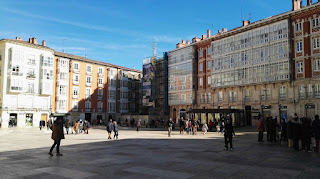Este blog está dedicado a viajes, cosas interesantes, cultura, anécdotas, etc.
domingo, 24 de enero de 2016
A 24 de Enero de 2016 en Burgos, Castilla-León, España.
Burgos es la histórica ciudad de Castilla que fue fundada por el Conde Diego Rodríguez el año 884, y hacia 930 se convierte en sede del Condado de Castilla. Los sucesores del Conde Fernán González mantienen en herencia el condado, y en 1.065 se convierte en Reino al ser dividida la herencia de Fernando I de León, que cede el Condado a título de Reino a su hijo Sancho II el Fuerte. Aunque Sancho consiguió reunificar la herencia de su padre, fue finalmente Alfonso VI, su hermano, el continuador de la dinastía con los Reinos de León y de Castilla unificados. Burgos fue la capital de los reinos unificados intermitentemente hasta los Reyes Católicos. En 1.512, Fernando V de Castilla y II de Aragón, el Rey Católico, firma las Leyes de Burgos, que garantizan el estatus de igualdad de los naturales de las Indias y son el germen de todos los documentos modernos de Derechos Humanos.
En la actualidad, Burgos pertenece a la Comunidad Autónoma de Castilla-León. Como Burgos y León habían sido las capitales históricas, pero en 1601-1606 Valladolid había sido capital de España y del Imperio, ha sido esta última la que actualmente ostenta la capitalidad de la Comunidad Autónoma.
Burgos tiene una de las catedrales más bella del mundo cristiano.
___________________________________________________________________________________________________________
Burgos is the historic town of Castile which was founded by Count Diego Rodríguez 884, and at 930 it becomes the seat of the County of Castile. The successors of Count Fernán González heritage kept in the county, and in 1065 became the capital of the Kingdom of Castile, when inheritance of Ferdinand I of León was divided, and the County became Kingdom with his son Sancho II the Strong. Although Sancho got reunify the legacy of his father, was finally Alfonso VI, his brother, who continues the dynasty with the Kingdoms of León and Castile unified. Burgos was the capital of kingdoms unified intermittently until the Catholic Monarchs. In 1512, Ferdinand V of Castile and II of Aragon, the Catholic King, signed the Laws of Burgos, ensuring the status of the natives of India and these Laws are the germ of all modern human rights documents.
Today, Burgos belongs to the autonomous community of Castilla-Leon. As Burgos and Leon had been the historical capital, but in 1601-1606 Valladolid was capital of Spain and the Empire, it was the latter that now is the capital of the Autonomous Community.
Burgos has one of the most beautiful cathedrals in the Christian world.
Suscribirse a:
Comentarios (Atom)

































